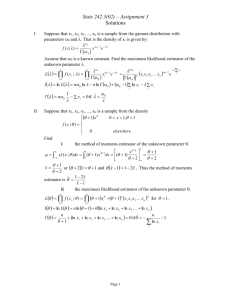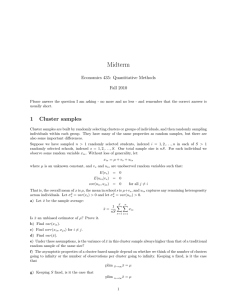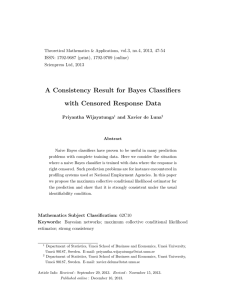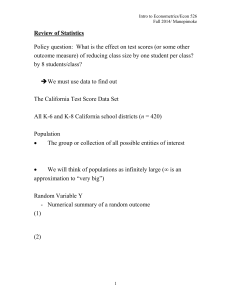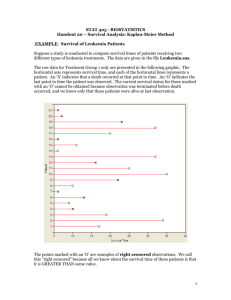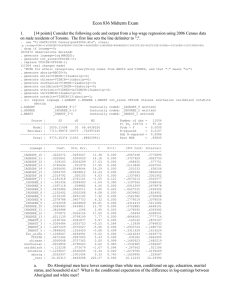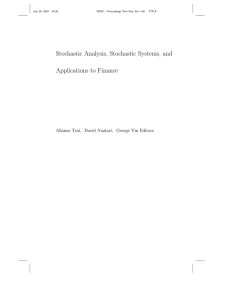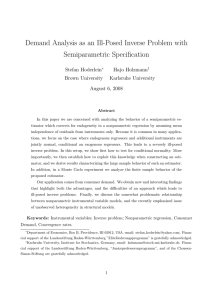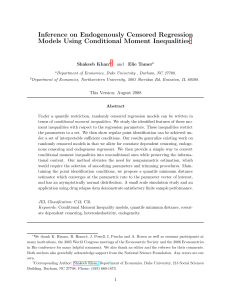Estimation of conditional survival function in fixed design regression
advertisement
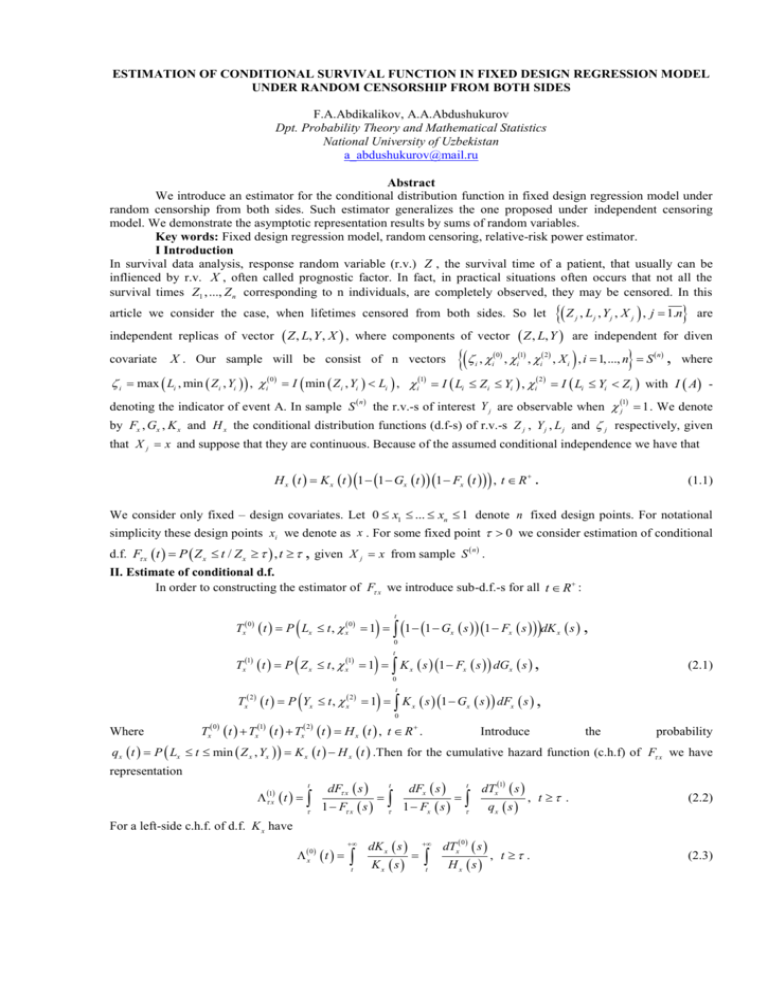
ESTIMATION OF CONDITIONAL SURVIVAL FUNCTION IN FIXED DESIGN REGRESSION MODEL UNDER RANDOM CENSORSHIP FROM BOTH SIDES F.A.Abdikalikov, A.A.Abdushukurov Dpt. Probability Theory and Mathematical Statistics National University of Uzbekistan a_abdushukurov@mail.ru Abstract We introduce an estimator for the conditional distribution function in fixed design regression model under random censorship from both sides. Such estimator generalizes the one proposed under independent censoring model. We demonstrate the asymptotic representation results by sums of random variables. Key words: Fixed design regression model, random censoring, relative-risk power estimator. I Introduction In survival data analysis, response random variable (r.v.) Z , the survival time of a patient, that usually can be inflienced by r.v. X , often called prognostic factor. In fact, in practical situations often occurs that not all the survival times Z1 ,..., Z n corresponding to n individuals, are completely observed, they may be censored. In this article we consider the case, when lifetimes censored from both sides. So let Z , L, Y , X , independent replicas of vector covariate where components of vector , X . Our sample will be consist of n vectors i max Li , min Z i , Yi , i 0 i 0 i j Z , L, Y j j j are are independent for diven , i1 , i 2 , X i , i 1,..., n S n , where I min Z i , Yi Li , i I Li Zi Yi , i 1 denoting the indicator of event A. In sample S Z , L , Y , X , j 1.n 2 I Li Yi Zi with I A - 1 the r.v.-s of interest Y j are observable when j 1 . We denote n by Fx , Gx , K x and H x the conditional distribution functions (d.f-s) of r.v.-s Z j , Y j , L j and j respectively, given that X j x and suppose that they are continuous. Because of the assumed conditional independence we have that H x t K x t 1 1 Gx t 1 Fx t , t R . (1.1) We consider only fixed – design covariates. Let 0 x1 ... xn 1 denote n fixed design points. For notational simplicity these design points xi we denote as x . For some fixed point 0 we consider estimation of conditional d.f. F x t P Z x t / Z x , t , given X j x from sample S n . II. Estimate of conditional d.f. In order to constructing the estimator of F x we introduce sub-d.f.-s for all t R : t Tx 0 t P Lx t , x 0 1 1 1 Gx s 1 Fx s dK x s , 0 t Tx1 t P Z x t , x1 1 K x s 1 Fx s dGx s , (2.1) 0 t Tx 2 t P Yx t , x 2 1 K x s 1 Gx s dFx s , 0 Where Tx 0 t Tx1 t Tx 2 t H x t , t R . Introduce the probability qx t P Lx t min Z x , Yx K x t H x t .Then for the cumulative hazard function (c.h.f) of F x we have representation t x t 1 dF x s t 1 F x s dFx s t 1 Fx s dTx1 s qx s , t . (2.2) For a left-side c.h.f. of d.f. K x have 0 x t t dK x s Kx s t dTx 0 s Hx s , t . (2.3) Let x t 1 1 Gx t 1 Fx t , Sp x t : 0 x t 1 , mx t : 0 xm t , m 0,1 Then a number K x , Gx , Fx we choose from conditions: inf tS p x , K x t 1 x t 0, (2.4) 0 x 1 x . - are Gasser-Müller type weights, given by Let ni x; hn , i 1, n xn 1 x y ni x; hn dy 0 hn hn 1 x i 1 x y dy , hn hn xi 1 Where x0 0, is known density function and hn 0 as n - sequence of bandwidths. Then the conditional d.f.-s (1.1) and (2.1) estimated by following Stone type kernel statistics for t R [2]: n H xh t ni x; hn I i t i 1 m Txh t ni x; hn I i n i 1 (2.5) m t , i 1 , m 0,1, 2 By solving the integral equation (2.3) with respect to d.f. K x and using estimates (2.5) we obtain the estimator of K x as dTxh 0 s K xh t exp ,t . t H xh s Then the probability qx t may be estimated by qxh t K xh t H xh t . (2.6) dTxh s Let 1xh t , t , is an estimate of c.h.f. (2.2). By using an ideas from [1], we introduce the q s xh t following relative – risk power estimator of conditional survival function 1 F x t : 1 1 F xh where R xh t xh 1 t dq s t xh qxh s q t t xh qxh R xh t , t , (2.7) 1 III. Asymptotic representation for estimator For investigating the estimator (2.7) we need in some notations and conditions. Let n min xi xi 1 , n max xi xi 1 , 1i n 1i n and introduce the conditions 1 1 (C1) As n , xn 1, n O , n n o ; n n (C2) Kernel have a compact support M , M , M 0 , u u du 0 and Let Nx t is Lipschitz of order 1; is some d.f. Consider the following conditions for all T TN x inf t : N x t 1 : x; t 0,1 0, T for some 2 2 2 and N t , N t N t N t N x t exist and continuous; x x x x xt x 2 t 2 sup t : H x t 0 and H x T TH x . (C3) N x t Let H x Theorem. Suppose that the conditions (2.4) (C1)-(C3) are hold and hn 0, Then for all t , T : n nhn5 log n 0, O 1 as n . nhn log n F xh t F x t ni x; hn tx i , i , i , i n i 1 log n a.s. where sup Rn t , x nhn t T 3 4 t txn i , i 0 , i1 , i 2 1 F x t I , i t, 1 i 1 x 1 T K x t H x t t 0 I I i , i1 1 Tx1 K x H x i 1 2 R n s H x s xh s dTx1 s K s H s x t t; x , I i 2 x s, 1 i 1 Tx1 s d K x s H x s , 2 K x s H x s and 0 I i s H x s dTx s H x2 s i 1 t n xh t K x t I I s, i 0 1 Tx 0 s dH x s 2 H x t Hx s t By using this theorem one can prove an asymptotically normality and weak convergence results for proposed estimators(2.7). References i t , i 0 1 Tx 0 t i [1] Abdushukurov A.A. Estimation of unknown distributions by incomplete observations and its properties, LAMBERT Academic Publishing, 301 p. 2011.(In Russian). [2] Stone C.J. Consistent nonparametric regression. //Ann. Statist. 1977. v.5. p.595-645.




